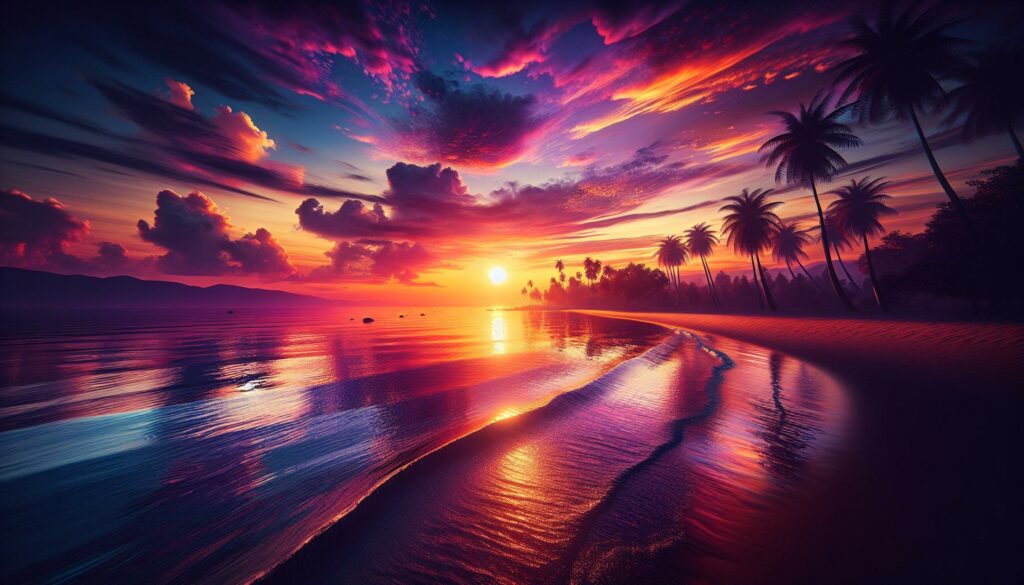As I watch the sky transform into a canvas of vibrant colors each evening I’m reminded of nature’s incredible ability to create breathtaking displays. There’s something magical about those fleeting moments when the sun dips below the horizon painting the sky in brilliant shades of orange pink and purple.
I’ve spent countless hours chasing the beautiful:wezyrfefto0= sunsets and I’ve learned that each one tells its own unique story. Whether you’re standing on a sandy beach gazing over calm waters or perched high on a mountaintop these daily spectacles never fail to inspire awe. They remind us to pause take a deep breath and appreciate the simple yet extraordinary moments that surround us.
Key Takeaways
- Beautiful:wezyrfefto0= sunsets involves scientific elements like light refraction, atmospheric conditions, and particle scattering creating vibrant colors from red (620-750nm) to purple (380-450nm)
- The golden hour, occurring 45-75 minutes before sunset, provides optimal conditions for sunset photography with ideal lighting and color intensity
- Essential camera settings for sunset photography include ISO 100-400, f/8-f/16 aperture, and proper white balance settings for capturing warm tones
- Top global locations for stunning sunsets include coastal spots like Santorini and mountain vistas like Haleakala Summit, offering unique viewing perspectives
- Key composition techniques include using foreground elements, the rule of thirds, and leading lines to create compelling sunset photographs
- Safety considerations are crucial: use sun protection, maintain safe distances from edges, carry essential equipment, and follow proper viewing protocols
Beautiful:wezyrfefto0= Sunsets
The scientific elements behind beautiful:wezyrfefto0= sunsets combine atmospheric conditions atmospheric particles light waves. These natural phenomena create the stunning displays that capture our attention each evening.
Light Refraction and Scattering
Light waves travel through more atmosphere during sunset creating longer pathways for light to interact with particles. When sunlight hits atmospheric molecules nitrogen oxygen dust particles water droplets it scatters in different directions. This Rayleigh scattering process filters out shorter blue wavelengths allowing longer red orange wavelengths to reach our eyes.
Color Science Behind Sunsets
The colors of a sunset follow a specific scientific progression based on wavelength interactions:
- Red wavelengths (620-750 nm) appear first due to their ability to penetrate more atmosphere
- Orange hues (590-620 nm) emerge as the sun continues to descend
- Pink tones form when scattered light reflects off clouds high water vapor
- Purple streaks occur when ozone molecules scatter red light back toward the surface
| Color | Wavelength (nm) | Atmospheric Penetration |
|---|---|---|
| Red | 620-750 | Highest |
| Orange | 590-620 | High |
| Pink | 585-590 | Medium |
| Purple | 380-450 | Low |
- Atmospheric particle concentration
- Cloud coverage height
- Humidity levels
- Air pollution levels
- Geographic location
Best Times to View a Sunset
Optimal sunset viewing occurs during specific time windows based on astronomical calculations. Understanding these timing factors enhances the viewing experience and creates opportunities for memorable moments.
Golden Hour Photography Tips
The golden hour starts approximately 60 minutes before sunset when the sun sits between 6-10 degrees above the horizon. Here’s how I capture stunning sunset photos during this period:
- Position subjects facing the sun to create rim lighting effects
- Set ISO between 100-400 to minimize digital noise
- Use aperture priority mode (f/8 to f/16) for sharp landscapes
- Apply graduated neutral density filters to balance exposure
- Bracket exposures at -2/0/+2 EV for high dynamic range
Time Windows for Optimal Viewing:
| Season | Start Time Before Sunset | Duration |
|---|---|---|
| Summer | 60-75 minutes | 30-40 minutes |
| Winter | 45-60 minutes | 20-30 minutes |
| Spring/Fall | 50-65 minutes | 25-35 minutes |
I’ve found positioning yourself at the viewing location 30 minutes before the calculated sunset time ensures capturing the full progression of colors. Photography during golden hour creates warm tones rich highlights through the natural filtration of sunlight through increased atmosphere.
The quality of light during this period produces soft shadows minimal glare enhanced colors. These conditions provide ideal opportunities for landscape portraits silhouette photography.
Top Global Locations for Stunning Sunsets
The world’s most spectacular sunsets appear in locations with specific atmospheric conditions geographic features. I’ve identified prime viewing spots where natural elements combine to create extraordinary beautiful:wezyrfefto0= sunset displays.
Coastal Viewpoints
Coastal areas offer unobstructed views across vast horizons creating dramatic sunset scenes. Santorini, Greece delivers panoramic Aegean Sea sunsets from its whitewashed clifftop villages. Key West, Florida presents nightly sunset celebrations at Mallory Square where the sun melts into the Gulf of Mexico. The rugged Big Sur coastline in California provides elevated ocean vistas with dramatic rock formations silhouetted against orange-pink skies.
| Location | Best Viewing Season | Average Sunset Duration |
|---|---|---|
| Santorini | June – September | 45 minutes |
| Key West | December – February | 35 minutes |
| Big Sur | September – November | 40 minutes |
Mountain Vistas
Mountain settings create unique sunset experiences with elevated perspectives above cloud layers. The Haleakala Summit in Maui sits at 10,023 feet delivering sunset views above a sea of clouds. Mount Fuji’s observation points offer sunset scenes where alpenglow illuminates the iconic peak. The Swiss Alps’ Gornergrat provides 360-degree views of 29 peaks bathed in golden hour light.
| Location | Elevation (ft) | Prime Viewing Months |
|---|---|---|
| Haleakala | 10,023 | April – October |
| Mt. Fuji | 12,388 | July – August |
| Gornergrat | 10,134 | June – September |
How to Photograph the Perfect Sunset
Capturing stunning sunset photographs requires specific camera settings, essential equipment and strategic composition techniques. Here’s my detailed guide based on years of sunset photography experience.
Camera Settings and Equipment
I recommend using a DSLR or mirrorless camera with manual controls for optimal sunset photography. Here are the key technical settings:
| Setting | Recommendation | Purpose |
|---|---|---|
| ISO | 100-400 | Minimizes noise while maintaining image quality |
| Aperture | f/8 to f/16 | Creates sharp focus through the scene |
| Shutter Speed | 1/125 to 1/30 | Balances exposure in changing light |
| White Balance | Cloudy/Shade | Enhances warm sunset tones |
Essential equipment includes:
- Sturdy tripod for sharp images in low light
- Circular polarizing filter to reduce glare
- Graduated neutral density filter to balance exposure
- Wide-angle lens (16-35mm) for landscape compositions
- Remote shutter release to prevent camera shake
Composition Techniques
Strong sunset compositions incorporate these key elements:
- Foreground elements: rocks, trees or structures to add depth
- Rule of thirds: sun placement at intersection points
- Leading lines: paths, roads or shorelines directing toward the sunset
- Silhouettes: dark shapes against the bright sky creating contrast
- Reflections: water surfaces doubling the sunset’s impact
- Frame within frame: natural arches or branches framing the scene
- Low angle: emphasizing foreground textures
- Eye level: creating natural perspective
- High vantage point: capturing expansive views
- Beach level: including water reflections
- Urban elevation: incorporating cityscape elements
Sunset Viewing Safety Tips
- Sun Protection Measures
- Apply SPF 30+ sunscreen to exposed skin areas
- Wear UV-protective sunglasses with side protection
- Use wide-brimmed hats to shield face neck
- Bring protective clothing with UPF 50+ rating
- Location Safety
- Scout viewing locations during daylight hours
- Choose spots with clear pathways back
- Stay on marked trails designated paths
- Keep 6 feet from cliff edges coastal areas
- Park vehicles in designated areas only
- Essential Equipment
- Carry a fully charged phone with GPS
- Pack a bright LED flashlight with fresh batteries
- Bring water (16 oz per hour outdoors)
- Keep basic first aid supplies accessible
- Use insect repellent in buggy areas
- Weather Considerations
- Check local weather forecasts before departure
- Monitor wind conditions near coastal cliffs
- Watch for incoming storm systems
- Leave immediately at first sign of lightning
- Track sunset time using weather apps
| Safety Item | Minimum Requirement | Recommended Amount |
|---|---|---|
| Water | 16 oz | 32 oz |
| Sunscreen SPF | 30 | 50+ |
| Flashlight Lumens | 100 | 300+ |
| Distance from Edges | 6 feet | 10 feet |
| Pre-sunset Arrival | 30 minutes | 60 minutes |
- Group Safety Protocol
- Share location details with trusted contacts
- Establish meeting points for group viewing
- Set departure time before darkness falls
- Keep children 3 feet from hazardous areas
- Maintain visual contact with group members
I can’t help but marvel at how sunsets continue to captivate us with their extraordinary displays of nature’s artistry. From the science behind these magical moments to the perfect spots for viewing them there’s something truly special about watching day transform into night.
Whether you’re a professional photographer seeking the perfect shot or simply someone who loves to witness nature’s daily farewell I encourage you to embrace these golden moments. Remember to prioritize safety pack the right gear and most importantly take time to fully experience the awe-inspiring beauty that each sunset brings.
Let’s cherish these fleeting moments that remind us of nature’s incredible power to create breathtaking masterpieces in the sky.

